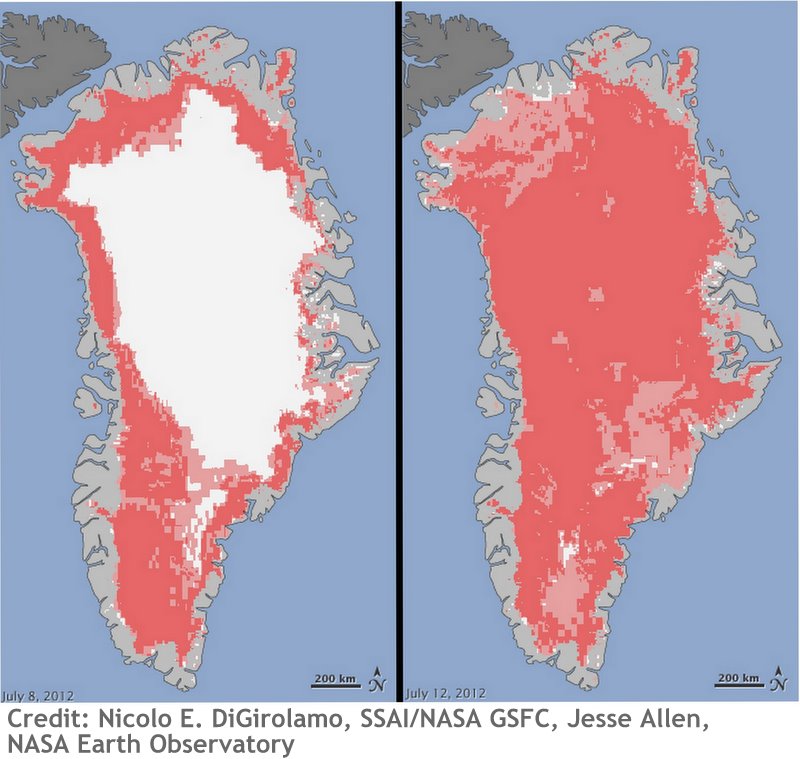Where Did All the Ice Go? The Media's Coverage of the Greenland Melt Event

Earlier this week the National Aeronautics and Space Administration (NASA) released a press statement describing an unusual melt event in Greenland, where, within a 4-day span, 97 percent of the island’s surface ice thawed. NASA’s press release, titled “Satellites see Unprecedented Greenland Ice Sheet Melt”, quickly sent national and international media outlets into overdrive covering this “unprecedented” melt event. Except, NASA botched the title of its press release and inaccurately described the melt event as “unprecedented”. According to the release similar melt events can be expected to occur every 150 years and the last recorded event happened in 1889. This would make the recent event unusual but far from unprecedented.
At that point, however, there was no stopping the media avalanche of inaccurate headlines and coverage, which largely failed to provide a nuanced and reasoned account of the important event in Greenland. Instead one could read sensationalist headlines describing how Greenland’s ice cover is melting away (The Independent), Greenland Goes Green: Greenland’s Ice Sheet Melts At Abnormal Blazing Speed (NPR), Greenland loses 97% of surface ice layer (NewScientist), The big thaw: Greenland ice cover is melting away (The Independent), Greenland’s Ice Sheet Melts at Fast and Furious Pace (VoA), Greenland’s ice sheet melted at unprecedented rate during July (The Guardian), Greenland’s ice sheet is melting fast (The Guardian).
Incorrect. The Greenland ice sheet, which is up to 3000+ meters thick, is not “melting away”, did not “melt in four days”, it is not “melting fast”, and Greenland did not “lose 97% of its surface ice layer”. Instead Greenland surface ice experienced thawing or melting across 97% of its area, most of which quickly refroze, especially at higher elevations. Only near the coast did some melt water drain into the ocean.
Most articles also exaggerated the importance of the melt event on global sea levels by explaining how sea levels would rise by up to 7.2 meters if the ice sheet were to melt. Here one example from The Independent: “The vast ice sheet of Greenland, which holds enough water to raise global sea levels by 7.2 metres, underwent a remarkable transformation for a few days this month when scientists observed an unprecedented melting of its frozen surface.”
Yes, the Greenland ice sheet is experiencing a significant amount of melting and up to 1/5th of global sea level rise can be attributed to it, but creating a connection between short term thawing of surface ice, which is related to a meteorological anomaly known as a heat dome, and the much larger ongoing climate change-related melting of the ice sheet is a misrepresentation of the events.
Unfortunately, as result of the kind of reporting Andrew Revkin described as “hyperventilating coverage”, the potential significance of the melt event was lost in most accounts. Accurate and nuanced reporting was far and few between. Here a few that got it right.
In his article for Climate Central Andrew Freeman asks “But what does this event mean in the bigger picture of ice melt and sea level rise, and what led to it in the first place?”
Ker Than, writing for National Geographic News, also provides an accurate analysis writing that “It may be tempting to link the event to global warming, but scientists say such melts might occur every 150 years.”
PBS’s Margaret Warner conducted an interview with Thomas Wagner, NASA Program Scientist for the cryosphere, which provides more insight into the matter as well. Still, PBS managed to botch its headline, writing Greenland Goes Green: Ice Sheet Melted in Four Days.
Here an excerpt of the interview:
MARGARET WARNER: Now, what explains [the melt]?
THOMAS WAGNER: […] Well, the simplest explanation is this, is we had some pockets of warm air really form around Greenland that literally washed up over the entire ice sheet. And a lot of that is related. If you look at — there are some indices people use to describe the state of the atmosphere. One of them is the North Atlantic oscillation. And this year, that happened to have a really strong high-pressure system formed over Iceland that allowed this warm air sit around and move over Greenland.
MARGARET WARNER: So, you’re basically talking about the weather?
THOMAS WAGNER: Yes, and that is one way to think about it. Climate is sort of long-term weather. But short term, you can get extreme variations. And we’re seeing an extreme variation in Greenland.
MARGARET WARNER: So, you’re saying you can’t really attribute this to climate change?
THOMAS WAGNER: No. And that’s one of the things. We spent a long time trying to word the document that we put out describing it. And we said, look, there is evidence that this has happened before. Now, that doesn’t mean — we really don’t know the explanation for this one. If it happens again, if it starts to happen repeatedly, then we have an indication that there might be a real shift going on in the Arctic system there.
A lot of media accounts also referenced the calving of Greenland’s Peterman Glacier as another example of the unusual events that occur in the region. Most articles, however, failed to explain that the two are separate events and are not related.
The sheer number of headlines exaggerating the importance of the event and the misinterpretation of its meaning is staggering. Such reporting provides a welcome opportunity for climate change skeptics and those questioning the soundness of climate science to plant the seed of doubt in the minds of the public. Part of the effort to implement lasting change capable of addressing the climate challenge needs to be the realization that exaggerations and the magnification of “dramatic” and “unprecedented” climate events may sell newspapers, but it also reduces the public’s ability to discern truly important climate events from mere meteorological events and thus diminishes the public’s willingness to be part of the solution to climate change.